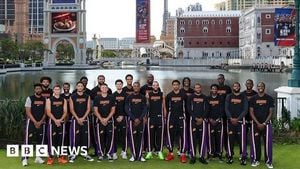In a tumultuous week for immigration policy in the United States, courts, advocacy groups, and federal agencies have collided over the fate of migrants, with children and workers at the heart of the latest developments. From the halls of Washington, D.C. to factories in New York and Georgia, the shifting landscape has left millions uncertain about their futures and sparked nationwide protests and legal showdowns.
On September 8, 2025, a federal immigration appeals panel delivered a sweeping decision that could affect millions of people: anyone in deportation proceedings who entered the U.S. without legal authorization is now ineligible for consideration of release on bond by an immigration judge, according to Politico. The ruling, which expands mandatory detention, means that a vast number of undocumented individuals awaiting their day in court may be held in custody for the duration of their proceedings, rather than being released while their cases are pending. Immigration advocates immediately decried the move, warning of overcrowded detention centers and the erosion of due process rights.
Meanwhile, in San Francisco, a judge blocked the Trump administration’s attempt to end legal protections for more than 1.1 million Venezuelans and Haitians, as reported by The Associated Press. The ruling preserves Temporary Protected Status (TPS) for some 600,000 Venezuelans and 500,000 Haitians, offering a reprieve to families who have built lives in the U.S. but faced sudden uncertainty. The decision comes as part of a broader trend, with judges across the country repeatedly halting aspects of the administration’s immigration agenda. According to USA Today, immigrant advocates argue that many of the proposed enforcement tactics violate existing laws and international agreements.
The tension spilled onto the streets of Washington, D.C., where thousands participated in the “We Are All D.C.” march—the first major organized protest since President Donald Trump deployed federal troops to the capital. Demonstrators voiced their opposition to what they called a “law enforcement takeover,” demanding respect for immigrants’ rights and an end to aggressive federal interventions. The Washington Post described the event as a pivotal moment, with activists and local residents uniting against policies they fear will upend their communities.
For some, the threat of deportation has taken on a personal and immediate urgency. Kilmar Armando Abrego Garcia, whose case had previously resulted in a court ruling against his removal to his homeland, was told on Friday, September 5, that he would instead be sent to Eswatini, a small African nation, The New York Times reported. The abrupt change left his lawyers scrambling for answers and underscored the unpredictability facing many in the system.
Enforcement actions have also targeted workplaces. In upstate New York, federal agents raided a snack bar manufacturer, detaining dozens of workers in a surprise operation that left the plant’s co-owner shaken. “It was terrifying,” the owner told The Associated Press and CNN, describing how agents forced open doors and rounded up employees. In the Bronx, more than 200 workers at the Perrigo pharmaceutical plant have been on strike since September 2, protesting management’s threats to cut overtime and expand shifts, according to THE CITY. The labor unrest comes as immigrant workers face mounting pressures from both employers and law enforcement.
Beyond U.S. borders, the international ripple effects are being felt. South Korea announced it had finalized negotiations with the U.S. to bring home 300 workers detained during a massive raid at a Hyundai plant in Georgia. As The Associated Press and The New York Times detailed, a charter plane will be dispatched as soon as administrative steps are completed, highlighting the global dimension of U.S. immigration enforcement.
In Massachusetts, the Trump administration launched a new Immigration and Customs Enforcement (ICE) operation, blaming Boston Mayor Michelle Wu’s sanctuary policies for what they described as a surge in undocumented residents. The Guardian reported that the move has sparked fresh controversy, with local officials and immigrant advocates vowing to resist federal pressure. Meanwhile, in Illinois, Governor J.B. Pritzker and Chicago Mayor Brandon Johnson publicly criticized President Trump after he promised on social media to take action against the city, according to ABC News. Their pushback reflects a growing trend of state and local leaders challenging federal immigration directives.
Amid these high-profile confrontations, the plight of migrant children has become a flashpoint. On September 5, the Arizona-based Florence Immigrant & Refugee Rights Project (FIRRP) filed a lawsuit to block the U.S. government from deporting a dozen Honduran children, citing credible information that such removals were imminent. This legal maneuver followed an earlier suit that temporarily halted the deportation of dozens of Guatemalan migrant children, The Associated Press reported. FIRRP stated, “We have received reports that the U.S. government will imminently move forward with a plan to illegally remove Honduran children in government custody as soon as this weekend, in direct violation of their right to seek protection in the United States and despite ongoing litigation that blocked similar attempted extra-legal removals for children from Guatemala.”
Over Labor Day weekend, the Trump administration attempted to remove 76 Guatemalan children who had arrived in the U.S. alone and were living in shelters or foster care. According to filings by the Justice Department, 457 Guatemalan children were initially identified for possible deportation, with 327 deemed eligible—including the 76 who were placed on planes early Sunday, September 7. All were at least 14 years old and had self-reported a parent or legal guardian in Guatemala, but none in the U.S. Despite claims in court that a plane may have taken off, no flights ultimately departed, and a federal judge ordered the children to remain in the U.S. for at least two weeks while their cases are reviewed.
Children who cross the border alone are typically transferred to the Office of Refugee Resettlement, part of the Department of Health and Human Services, where they live in a network of shelters until released to a relative or sponsor. A 2008 law requires that such children appear before an immigration judge, with the opportunity to seek asylum—unless they are from Canada or Mexico. Most are eventually released while their cases proceed, but the recent attempts at swift deportation have alarmed advocates, who say the government is sidestepping legal protections. The FIRRP lawsuit now includes 12 Honduran children who have told the group they do not want to return, as well as four additional Guatemalan children who have recently come into government custody in Arizona. The suit demands that the government allow the children their legal right to present their cases, have access to counsel, and be placed in the least restrictive setting possible.
As legal battles rage and policy shifts continue, the human toll of America’s immigration debate is increasingly visible—in courtrooms, on factory floors, and in the lives of children waiting for answers. The coming weeks promise more uncertainty, but for now, legal protections remain a fragile lifeline for many caught in the crosshairs of enforcement and reform.




